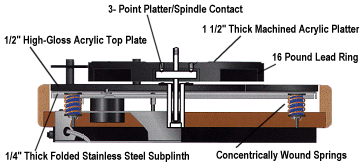The matter of the different bearings and platters VPI used on the various incarnations of the HW-19, Aries, and TNT tables is a little convoluted, and can be confusing.
But first, the Mk.3 HW-19 does NOT have a stainless steel sub-platter, it has a non-stainless steel sheet painted black. The stainless steel sheet was introduced in the Mk.4 version, and is unpainted.
Now, onto the bearings and platters:
- The bearing used in the HW-19 Mk.1 through 3 are identical: it has an aluminum housing with an outer diameter of 1", the top of the housing having a flange with three holes through which bolts pass to secure the housing to the floating sub-chassis.
- The Mk.1 platter was a solid piece of 1" thick aluminum, with a thin layer of lead bonded to it’s underside, covered in cork. The Mk.2 and MK.3 platters are also 1" thick, but made of black Delrin, with the same lead/cork layer bonded to the underside.
- The MK.4 version has a 1.5" thick black Delrin platter, again with the lead/cork layer on the bottom. What I am not sure about is if the Mk.4 has the same bearing, or instead the one VPI introduced in the original TNT, and also incorporated in the original Aries. This new bearing has a housing also 1" in diameter, but is made of stainless steel. And instead of three holes in the mounting flange for mounting bolts, the outside of the housing is threaded, the housing secured to the plinths of the TNT and Aries with a nut tightened from below.
- However, VPI also made the stainless steel housing in a version with an outer diameter of 1.25", and used it in different incarnations of the TNT. On the other hand, all original Aries tables are fitted with the 1" housing. Confused yet? ;-)
- Both the HW-19 Mk.1 through 3 and the original Aries have a mounting hole sized to accept a bearing housing of 1". However, some TNT’s came with the 1" bearing, others with the 1.25" version. When looking for a TNT platter/bearing to install on an HW-19, look for one with the 1" bearing (to precluded needing to enlarge the mounting hole in the sub-chassis).
- The use of the term "Mk.4" in the above posts is somewhat confusing, as the platter introduced in the HW-19 Mk.4, and the platter used in the TNT Mk.4 are different from one another. The HW-19 Mk.4 is, as I noted above, a solid piece of 1.5" thick black Delrin. The TNT Mk.3 and Mk.4 platters are identical to one another: a bottom layer of 7/8" thick aluminum with the lead/cork combo bonded to its underside, with a top later of 3/8" thick Delrin, for a combined thickness of 1.25". This same platter was used in the original Aries. I believe the TNT Mk.1 and Mk.2 had the same platter as the HW-19 Mk.4.
- A popular upgrade for the HW-19 is one of the TNT platters. The two considered the "best" by many are the just described TNT MK.3 and 4/Aries, and then the TNT Mk.5, which is different: the MK.5 has a bottom layer of 5/8" thick stainless steel (without the lead/cork combo on its bottom side) with a top layer of 7/8" thick Delrin, for a combined thickness of 1.5"
- In the TNT Mk.6, VPI switched to an inverted bearing (with I believe an outer diameter of 1.25:) and a frosted white Acrylic platter. This platter is now considered a mis-step on VPI’s part---even by Harry Weisfeld---and was replaced with the current aluminum platters, still with an inverted bearing.
- The Super Platter evolved out of the TNT Mk.5 platter. It has an inner section of stainless steel, with a layer of Delrin both top and bottom, a stainless steel/Delrin sandwich, so to speak. It uses the VPI inverted bearing.
- Amongst VPI enthusiasts, there are those who prefer the TNT MK.5 platter above all others, some the TNT Mk.3/4/Aries platter, others the Super Platter (though others still finding it to be too "damped" sounding). But there are also those who like the current aluminum Classic platter. As with everything in hi-fi, it’s a matter of taste.
- Now, as to electronic speed control: If you are patient, wait until the no-longer-in-production Phoenix Engineering Eagle/Roadrunner combo comes up for sale used. MUCH better than any of VPI’s controllers. Or look into the version of same currently available from SOTA, which with a slight modification can be used with the VPI motors.
- Speaking of motors: one excellent HW-19 upgrade is the VPI SAMA---the Stand Alone Motor. It is the Hurst-sourced VPI motor mounted into a free-standing heavy pod, used in place of the same motor mounted on the HW-19’s outer frame. The SAMA designed expressly for the HW-19 is no longer available, but they occasionally come up for sale.


![[Image: 24831228_1766333486730947_40473016948644...e=62F62193]](https://scontent-sea1-1.xx.fbcdn.net/v/t31.18172-8/24831228_1766333486730947_4047301694864409360_o.jpg?_nc_cat=108&ccb=1-7&_nc_sid=825194&_nc_ohc=Jc-M5Pw9pxQAX9vBPo6&tn=TBBNftCPZjO-CFQk&_nc_ht=scontent-sea1-1.xx&oh=00_AT-cTc3HtQnGjH_aBW8lNj6vpRluMVMdRNuHW99YwBkBEA&oe=62F62193)
